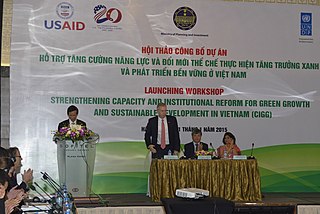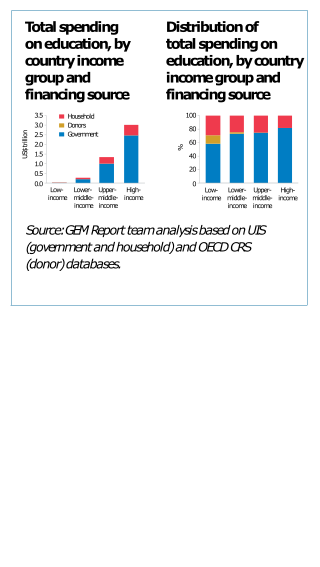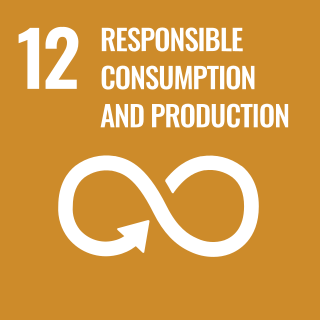Sources
![]() This article incorporates text from a free content work. Licensed under CC BY-SA( license statement/permission ). Text taken from Issues and trends in Education for Sustainable Development , UNESCO.
This article incorporates text from a free content work. Licensed under CC BY-SA( license statement/permission ). Text taken from Issues and trends in Education for Sustainable Development , UNESCO.
Monitoring Education for Sustainable Development (ESD) refers to measuring progress in ESD learning compared to policy commitments, provision, institutional support, resources and others. Monitoring and evaluation (M&E) of Education for Sustainable Development is widely discussed in literature on ESD, including debates regarding methodology and strategies for interpreting the data. [1]
New information, analysis and predictions feed into ‘improve[d] decision making and action-taking’ to guide and reorient programmes. This process increases understanding about the elements necessary to promote ESD learning in a particular context, and can influence other stakeholders. The desired outcome is wider social learning and enhanced ESD knowledge and skills, potentially resulting in diverse activities that promote not just better learning but the ultimate goal of ESD: sustainable living throughout life. [2]
A main requirement of effective M&E in education and learning is clear objectives, also called competencies, which stem from defined concepts in a subject. The more dynamic aspects of ESD cannot be boxed into a measurable definition because they centre on the unknown and the emergent: they revolve around new concepts and ideas produced by learners to help populations confront global issues such as climate change. It is not always possible to know what to monitor because learners are partially leading the process. Differentiating ESD from two subject areas is challenging because it is often lumped together with – its precursor, environmental education (EE), and global citizenship education (GCED), which runs complementarily. [2]
There is a governance and accountability angle to M&E of ESD. It involves verifying that all learners have access, that the process is inclusive and that the learning provided is suitable. At the national level, it is crucial that education authorities be in a position to account for how a significant share of public expenditure (supplemented by sizeable private investment) is ensuring the right of all children, youth and adults to basic educational opportunities that lead to effective and relevant learning. M&E also accounts ‘for ensuring equal opportunity for post-basic education and training’. [2]
Monitoring is not only concerned with learning, but effective learning for all, and therefore operates from a position of social justice. It helps to keep special interests and the marketization of education in check, by regulating the private sector to ‘ensure the application of standards adopted by education professionals working in both public and private sectors’. M&E aims to protect and uphold access to quality education for all people throughout life by reining in potentially dominant special interest forces. [2]
From 2005 to 2014, UNESCO worked on prioritizing and advancing ESD. Based on United Nations General Assembly Resolution 57/254, the UN Decade of Education for Sustainable Development (DESD) was conceived as a way to foreground principles and practices of sustainability and marry them with education and learning. This marriage aimed to strengthen ESD worldwide with a view to effecting positive, sustainable change in the ways that people – in this case, learners – make choices and live their lives in relationship to others and their local environment, ultimately transforming broader social behaviour and its effects on the planet. The conclusion was that it was necessary to monitor efforts to observe the kind of progress being made. This information could be fed back into the process leading to changes and improvements resulting in better ESD learning. The common practice was to measure ESD through inputs, including the ‘development of strategies, plans, coordinating mechanisms and resources’. This approach reflected a more top-down approach to M&E often driven by national reporting to international agencies. It was also representative of a belief that inputs inevitably lead to outputs. However, the effect of inputs and throughputs on ESD learning proved difficult to see. [3]
This suggested three things:
This mix reflects the balance and tension between translating global and local concerns into goals and targets, and having indicators that help collect information on activities that demonstrate progress towards them. Both are important, as the wider call for sustainable development is a response to overarching, multifaceted (global) problems, such as climate change and specific (local) manifestations and effects on different places for actual people. During the Decade, the DESD Monitoring and Evaluation Expert Group (MEEG) developed various ESD indicators as part of their Global Monitoring and Evaluation Framework. Early involvement of stakeholders and establishing agreed-upon goals will be vital to addressing this indicator development challenge’. Coordination between National Commissions and designated working groups led to various types of indicator development bodies each with different purposes. This strategy resulted in an open and connected process that was part of a larger M&E scheme. [4]
An outcome from the Decade is that many M&E experts now believe in evaluating programmes and practices at multiple levels and stages of the educational process. Possible multipronged frameworks involve large-scale student assessments and country-level and lower assessments related to contextualized ESD aims and purposes. This may include evaluation of the learning environment focusing on pedagogy and learner engagement, and formative assessments to improve professional practice among teachers through peer engagement. [5]
Finding data on how countries monitor ESD has proven difficult. References in the literature to country approaches to M&E invariably follow the model of collecting and analysing policies, capacity-building efforts, implementation, earning objectives, teacher and curriculum, partnerships and networks, and so on. There is little mention of holistic schemes or systems operating in unison. Some instances provide decontextualized discussions about indicators and assessments to evaluate learning outcomes. As these discussions are not part of a larger whole or anchored to country activities, they lose their concrete value and simply amount to a reiteration of oversimplified, input leads-to-output thinking without any information about what happens between inputs and learning outcomes. There are a few examples of studies where M&E of ESD within countries could have been inquired about and pointed to, but were not for some reason. [6]
The United Nations Economic Commission for Europe (UNECE) Initiative on Education for Sustainable Development includes an objective to ‘promote research on and development of ESD. However, the ten-year evaluation report on implementation does not provide examples of monitoring, and notes only that more and better practices are needed. The United Nations University Institute of Advanced Studies (UNU-IAS) and the Institute for Global Environmental Strategies (IGES) collaborated on a research project with the UNESCO Asia and Pacific Regional Bureau for Education on M&E for ESD in 2011 to 2012. The study covered nine countries in North and Southeast Asia over two rounds of surveys using a mixed-methods approach (both quantitative and qualitative with a bridge connecting the two data sets). Similar to the UNECE report, key input, content and process areas were examined. There is lengthy discussion in the final report about the benefits and deficiencies of monitoring, but an absence of country cases to illustrate these points. Examples of what is described and promoted as good practice can be useful. [6]
A publication developed by UNESCO in 2013 entitled National Journeys towards Education for Sustainable Development offers some detail and analysis of M&E in countries within the five world regions, focusing on: Costa Rica, Morocco, South Africa, Sweden and Viet Nam. In the case of Costa Rica, monitoring is addressed but mostly in relation to sustainable human development through the annual report, State of the Nation. Further leadership is mentioned as a key concern – one that also impacts M&E. According to the report, Morocco does not appear to have a comprehensive ESD M&E approach in place, including indicators. [7]
Accordingly, the report advocates for using SWOT (strengths, weaknesses, opportunities and threats) to evaluate performance. Versions of this approach are also applied to other country profiles in the report. According to the publication, South Africa has a strong tradition of M&E in ESD, and implemented the National Environmental Education Project for General Education and Training (NEEP-GET). This is ‘one of the largest, most comprehensive formative monitoring and evaluation (FME) processes’, which focused on ‘contextual monitoring and longitudinal studies, as well as critical appraisals of key issues’. In Sweden, the Institute for Research in Education and Sustainable Development (IRESD) is ‘one of the most expansive and acclaimed research environments for education and sustainable development in Sweden’. However, the report does not provide information on how this links to monitoring ESD. According to the publication, Viet Nam's approach is focused on ‘project based mechanisms and indicators’. This includes manuals and guidelines for M&E of ESD, and relevant teacher training. [7]
Evidence shows that many countries are only getting started. The process of developing holistic, multipronged M&E systems for tracking ESD is still in the early stages. More needs to be done (and documented) with an emphasis on the driving reason for monitoring ESD in the first place: to gain information to make good decisions about policies, provision, institutional support, resources, and so on, that lead to better ESD learning and, ideally, broader sustainable behavior. [7]
![]() This article incorporates text from a free content work. Licensed under CC BY-SA( license statement/permission ). Text taken from Issues and trends in Education for Sustainable Development , UNESCO.
This article incorporates text from a free content work. Licensed under CC BY-SA( license statement/permission ). Text taken from Issues and trends in Education for Sustainable Development , UNESCO.

Sustainable development is an organizing principle that aims to meet human development goals while also enabling natural systems to provide necessary natural resources and ecosystem services to humans. The desired result is a society where living conditions and resources meet human needs without undermining the planetary integrity and stability of the natural system. Sustainable development tries to find a balance between economic development, environmental protection, and social well-being. The Brundtland Report in 1987 defined sustainable development as "development that meets the needs of the present generation without compromising the ability of future generations to meet their own needs". The concept of sustainable development nowadays has a focus on economic development, social development and environmental protection for future generations.
International education refers to a dynamic concept that involves a journey or movement of people, minds, or ideas across political and cultural frontiers. It is facilitated by the globalization phenomenon, which increasingly erases the constraints of geography on economic, social, and cultural arrangements. The concept involves a broad range of learning, for example, formal education and informal learning. It could also involve a reorientation of academic outlook such as the pursuit of "worldmindedness" as a goal so that a school or its academic focus is considered international. For example, the National Association of State Universities prescribes the adoption of "proper education" that reflects the full range of international, social, political, cultural, and economic dialogue. International educators are responsible for "designing, managing, and facilitating programs and activities that help participants to appropriately, effectively, and ethically engage in interactions with culturally diverse people and ideas."
The Centre for Environment Education (CEE) in India was established in August 1984 as a Centre of Excellence supported by the Ministry of Environment and Forests. The organisation works towards developing programmes and materials to increase awareness about the environment and sustainable development. The head office is located in Ahmedabad. The centre has 41 offices across India including regional cells in Bangalore (South), Guwahati, Lucknow (North), Ahmedabad (West) and Pune (Central); state offices in Delhi, Hyderabad, Raipur, Goa, Coimbatore; and several field offices. It has international offices in Australia and Sri Lanka.

Capacity building is the improvement in an individual's or organization's facility "to produce, perform or deploy". The terms capacity building and capacity development have often been used interchangeably, although a publication by OECD-DAC stated in 2006 that capacity development was the preferable term. Since the 1950s, international organizations, governments, non-governmental organizations (NGOs) and communities use the concept of capacity building as part of "social and economic development" in national and subnational plans. The United Nations Development Programme defines itself by "capacity development" in the sense of "'how UNDP works" to fulfill its mission. The UN system applies it in almost every sector, including several of the Sustainable Development Goals to be achieved by 2030. For example, the Sustainable Development Goal 17 advocates for enhanced international support for capacity building in developing countries to support national plans to implement the 2030 Agenda.

The Decade of Education for Sustainable Development (DESD) 2005–2014 was an Education for Sustainable Development (ESD) initiative of the United Nations. The Decade was delivered by UNESCO as lead agency, and gave rise to Regional Centres of Expertise (RCE) networks, and the GUPES universities' partnership. The launch of the United Nations Decade of Education for Sustainable Development started a global movement to reorient education to address the challenges of sustainable development. It was the first UN Decade to establish a global monitoring and evaluation process and expert group. Building on the achievement of the Decade, stated in the Aichi-Nagoya Declaration on ESD, UNESCO endorsed the Global Action Programme on ESD (GAP) in the 37th session of its General Conference. Acknowledged by UN general assembly Resolution A/RES/69/211 and launched at the UNESCO World Conference on ESD in 2014, the GAP aims to scale-up actions and good practices. UNESCO has a major role, along with its partners, in bringing about key achievements to ensure the principles of ESD are promoted through formal, non-formal and informal education.

The International Programme for the Development of Communication is a United Nations Educational, Scientific and Cultural Organization (UNESCO) programme aimed at strengthening the development of mass media in developing countries.
The UNESCO Institute for Statistics (UIS) is the statistical office of UNESCO and is the UN depository for cross-nationally comparable statistics on education, science and technology, culture, and communication.

Theory of Change (ToC) is a methodology or a criterion for planning, participation, adaptive management, and evaluation that is used in companies, philanthropy, not-for-profit, international development, research, and government sectors to promote social change. Theory of Change defines long-term goals and then maps backward to identify necessary preconditions.
Participatory evaluation is an approach to program evaluation. It provides for the active involvement of stakeholder in the program: providers, partners, beneficiaries, and any other interested parties. All involved decide how to frame the questions used to evaluate the program, and all decide how to measure outcomes and impact. It is often used in international development.

The Sustainable Development Goals (SDGs) or Global Goals are a collection of seventeen interlinked objectives designed to serve as a "shared blueprint for peace and prosperity for people and the planet, now and into the future." The short titles of the 17 SDGs are: No poverty (SDG 1), Zero hunger (SDG 2), Good health and well-being (SDG 3), Quality education (SDG 4), Gender equality (SDG 5), Clean water and sanitation (SDG 6), Affordable and clean energy (SDG 7), Decent work and economic growth (SDG 8), Industry, innovation and infrastructure (SDG 9), Reduced inequalities (SDG 10), Sustainable cities and communities (SDG 11), Responsible consumption and production (SDG 12), Climate action (SDG 13), Life below water (SDG 14), Life on land (SDG 15), Peace, justice, and strong institutions (SDG 16), Partnerships for the goals (SDG 17).
Monitoring and Evaluation (M&E) is a combined term for the processes set up by organizations such as companies, government agencies, international organisations and NGOs, with the goal of improving their management of outputs, outcomes and impact. Monitoring includes the continuous assessment of programmes based on early detailed information on the progress or delay of the ongoing assessed activities. Evaluation involves the examination of the relevance, effectiveness, efficiency and impact of activities in the light of specified objectives.
Global citizenship education (GCED) is a form of civic learning that involves students' active participation in projects that address global issues of a social, political, economic, or environmental nature. The two main elements of GCE are 'global consciousness'; the moral or ethical aspect of global issues, and 'global competencies', or skills meant to enable learners to participate in changing and developing the world. The promotion of GCE was a response by governments and NGOs to the emergence of supranational institution, regional economic blocs, and the development of information and communications technologies. These have all resulted in the emergence of a more globally oriented and collaborative approach to education. GCE addresses themes such as peace and human rights, intercultural understanding, citizenship education, respect for diversity and tolerance, and inclusiveness.
Inclusive education in Latin America aims at giving all people of the region the right to access education. Its development consists of four aspects that may define the position of the debate on inclusive education in the region:
TVET refers to all forms and levels of education and training which provide knowledge and skills related to occupations in various sectors of economic and social life through formal, non-formal and informal learning methods in both school-based and work-based learning contexts. To achieve its aims and purposes, TVET focuses on the learning and mastery of specialized techniques and the scientific principles underlying those techniques, as well as general knowledge, skills and values.

Action for Climate Empowerment (ACE) is a term adopted by the United Nations Framework Convention on Climate Change (UNFCCC). It refers to Article 6 of the Convention's original text (1992), focusing on six priority areas: education, training, public awareness, public participation, public access to information, and international cooperation on these issues. The implementation of all six areas has been identified as the pivotal factor for everyone to understand and participate in solving the complex challenges presented by climate change. The importance of ACE is reflected in other international frameworks such as the Sustainable Development Goals ; the Global Action Programme for Education for Sustainable Development ; the Aarhus Convention (2011); the Escazú Agreement (2018) and the Bali Guidelines (2010).

Climate change education (CCE) is education that aims to address and develop effective responses to climate change. It helps learners understand the causes and consequences of climate change, prepares them to live with the impacts of climate change and empowers learners to take appropriate actions to adopt more sustainable lifestyles. Climate change and climate change education are global challenges that can be anchored in the curriculum in order to provide local learning and widen up mindset shits on how climate change can be mitigated. In such as case CCE is more than climate change literacy but understanding ways of dealing with climate

Large-scale learning assessments (LSLAs) is defined as a form of national or cross-national standardized testing that provide a snapshot of learning achievement for a group of learners in a given year and in a limited number of learning domains.

Sustainable Development Goal 12, titled "responsible consumption and production", is one of the 17 Sustainable Development Goals established by the United Nations in 2015. The official wording of SDG 12 is "Ensure sustainable consumption and production patterns". SDG 12 is meant to ensure good use of resources, improve energy efficiency and sustainable infrastructure, provide access to basic services, create green and decent jobs, and ensure a better quality of life for all. SDG 12 has 11 targets to be achieved by at least 2030, and progress towards the targets is measured using 13 indicators.

Sustainable Development Goal 4 is about quality education and is among the 17 Sustainable Development Goals established by the United Nations in September 2015. The full title of SDG 4 is "Ensure inclusive and equitable quality education and promote lifelong learning opportunities for all".
The learning crisis or global learning crisis is a term describing the fact that, despite a large increase in access to schooling, learning outcomes remain poor, especially in developing countries. Worldwide, millions of children who attend school do not acquire basic skills such as literacy and numeracy, and many more are far behind age-appropriate expectations in their national curricula. Proponents argue that this crisis needs to be addressed due to the importance of education in fostering children's development, social mobility, and subsequent opportunities.
{{cite web}}: Check |url= value (help)